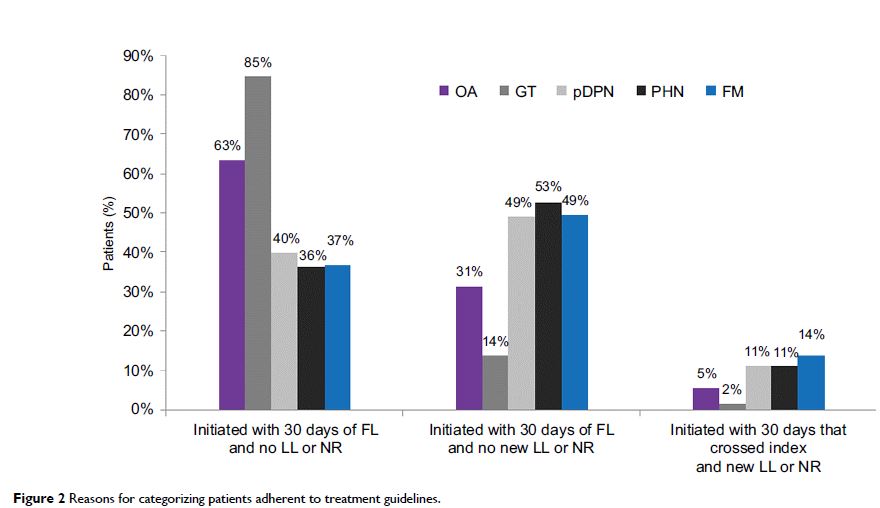9 9 6 5 3
论文已发表
注册即可获取德孚的最新动态
IF 收录期刊
- 3.3 Breast Cancer (Dove Med Press)
- 3.4 Clin Epidemiol
- 2.5 Cancer Manag Res
- 2.9 Infect Drug Resist
- 3.5 Clin Interv Aging
- 4.7 Drug Des Dev Ther
- 2.7 Int J Chronic Obstr
- 6.6 Int J Nanomed
- 2.5 Int J Women's Health
- 2.5 Neuropsych Dis Treat
- 2.7 OncoTargets Ther
- 2.0 Patient Prefer Adher
- 2.3 Ther Clin Risk Manag
- 2.5 J Pain Res
- 2.8 Diabet Metab Synd Ob
- 2.8 Psychol Res Behav Ma
- 3.0 Nat Sci Sleep
- 1.8 Pharmgenomics Pers Med
- 2.7 Risk Manag Healthc Policy
- 4.2 J Inflamm Res
- 2.1 Int J Gen Med
- 4.2 J Hepatocell Carcinoma
- 3.7 J Asthma Allergy
- 1.9 Clin Cosmet Investig Dermatol
- 2.7 J Multidiscip Healthc

Development of a novel algorithm to determine adherence to chronic pain treatment guidelines using administrative claims
Authors Margolis JM, Princic N, Smith DM, Abraham L, Cappelleri JC, Shah SN, Park PW
Received 27 July 2016
Accepted for publication 16 November 2016
Published 8 February 2017 Volume 2017:10 Pages 327—339
DOI https://doi.org/10.2147/JPR.S118248
Checked for plagiarism Yes
Review by Single-blind
Peer reviewers approved by Dr Amy Norman
Peer reviewer comments 2
Editor who approved publication: Dr Michael E Schatman
Objective: To develop a claims-based algorithm for identifying patients who are
adherent versus nonadherent to published guidelines for chronic pain
management.
Methods: Using medical and pharmacy health care claims from the MarketScan®
Commercial and Medicare Supplemental Databases, patients were selected during
July 1, 2010, to June 30, 2012, with the following chronic pain conditions:
osteoarthritis (OA), gout (GT), painful diabetic peripheral neuropathy (pDPN),
post-herpetic neuralgia (PHN), and fibromyalgia (FM). Patients newly diagnosed
with 12 months of continuous medical and pharmacy benefits both before and
after initial diagnosis (index date) were categorized as adherent, nonadherent,
or unsure according to the guidelines-based algorithm using disease-specific
pain medication classes grouped as first-line, later-line, or not recommended.
Descriptive and multivariate analyses compared patient outcomes with
algorithm-derived categorization endpoints.
Results: A total of 441,465 OA patients, 76,361 GT patients, 10,645 pDPN, 4,010
PHN patients, and 150,321 FM patients were included in the development of the
algorithm. Patients found adherent to guidelines included 51.1% for OA, 25% for
GT, 59.5% for pDPN, 54.9% for PHN, and 33.5% for FM. The majority (~90%) of
patients adherent to the guidelines initiated therapy with prescriptions for
first-line pain medications written for a minimum of 30 days. Patients
found nonadherent to guidelines included 30.7% for OA, 6.8% for GT, 34.9% for
pDPN, 23.1% for PHN, and 34.7% for FM.
Conclusion: This novel algorithm used real-world pharmacotherapy treatment patterns
to evaluate adherence to pain management guidelines in five chronic pain
conditions. Findings suggest that one-third to one-half of patients are managed
according to guidelines. This method may have valuable applications for health
care payers and providers analyzing treatment guideline adherence.
Keywords: chronic pain, drug therapy, practice guidelines, adherence, algorithm
